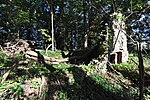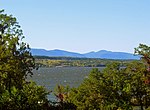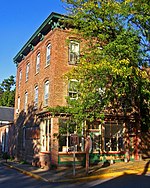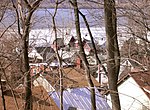Heermance House and Law Office
Dutchess County, New York Registered Historic Place stubsHouses completed in 1858Houses in Rhinebeck, New YorkHouses on the National Register of Historic Places in New York (state)Italianate architecture in New York (state) ... and 3 more
Law officesLegal history of New York (state)National Register of Historic Places in Dutchess County, New York

Heermance House and Law Office is a historic home located at Rhinecliff, Dutchess County, New York. Located on the property is a cottage, built about 1858 in the Picturesque Italianate style; the Gothic-inspired law office building, built about 1886; and a garage, built about 1900. The house is a two-story, three bay building with a broad picturesque verandah, ornamental brackets, and pierced woodwork. It has a long, two story, gable roofed rear wing. The law office building is a small, one story frame structure sheathed in clapboard.It was added to the National Register of Historic Places in 1987.
Excerpt from the Wikipedia article Heermance House and Law Office (License: CC BY-SA 3.0, Authors, Images).Heermance House and Law Office
Long Dock Road,
Geographical coordinates (GPS) Address Nearby Places Show on map
Geographical coordinates (GPS)
| Latitude | Longitude |
|---|---|
| N 41.928333333333 ° | E -73.944166666667 ° |
Address
Long Dock Road 5
12572
New York, United States
Open on Google Maps










